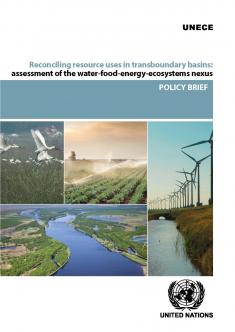This policy brief provides an introduction towards the different stages of and benefits from an assessment of the water-food-energy-ecosystems nexus, with a specific focus on resource use in transboundary basins. It summarizes the experience from the first three transboundary basins where a methodology for participatory assessment of intersectoral linkages, trade-offs and benefits in transboundary basins, developed under the Water Convention, was applied.
Management of transboundary basins involves the management of water, energy and land resources, such as agricultural land and forests. But management also involves the economic activities located in the basin and/or dependent on those resources – such as energy production, mining, industrial production, transport or tourism – as well as the social and environmental impact of the management of natural resources. Coordination between the water, energy, food and environment sectors is challenging even at the national level. But the complexity increases substantially in transboundary river basins where the impact spreads from one country to another and trade-offs and externalities may cause friction between the riparian countries.
This policy brief was developed by UNECE with the support of the Advisory Assistance Programme (AAP) of the German Environment Agency (Umweltbundesamt) in the frame of the project "Assessment of the water-food-energy-ecosystem nexus: dialogue in Sava Basin, Western Balkan". It first lays out the reasons why a transboundary Nexus approach is needed, followed by a methodology chapter dedicated to the assessment of Nexus projects. It then delivers solutions to address transboundary Nexus challenges, while showing up potential benefits of a transboundary Nexus approach.
The basin-level nexus assessment involves six steps that combine desk studies and participatory workshops. Step 1 focuses on the identification of basin conditions and the socioeconomic context. Step 2 focuses on the identification of key sectors and stakeholders to be included in the assessment. Step 3 focuses on the analysis of key sectors, including through indicators. Step 4 focuses on the identification of intersectoral issues. Step 5 consists of a nexus dialogue about, and the priority of, inter-linkage scenarios to be considered, and a preliminary understanding of the evolution of the inter-linkages under the different scenarios. Step 6 focuses on identifying synergies across sectors and countries.
The policy brief draws a number of conclusions and issues some recommendations.
ECE/MP.WAT/NONE/5


